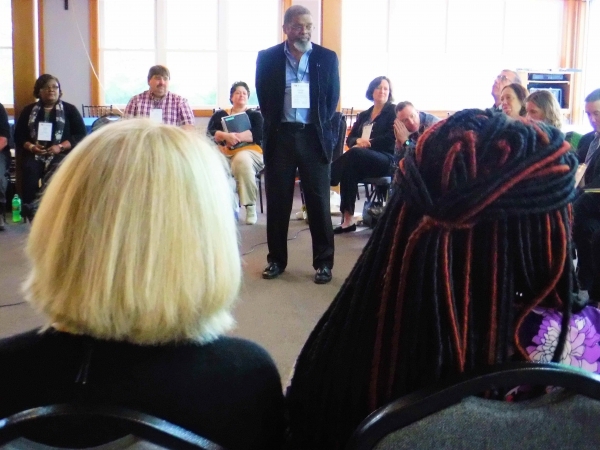BRATTLEBORO — Curtiss Reed Jr. has seen this fall's Saturday Night Live skit in which a self-identified “neo-Confederate” seeks “an agrarian community where everyone lives in harmony, because every single person is white.”
“That sounds like Vermont,” another character offers as a punchline.
But the subsequent 3.2 million and counting YouTube views aren't stopping Reed, the executive director of the Vermont Partnership for Fairness and Diversity, from working to rewrite the script.
“We're being painted in a way that's really unfortunate,” he said at the seventh annual Vermont Vision for a Multicultural Future Conference last week at Brattleboro's World Learning. “How do we make the state the most desirable destination for folks of color?”
Vermont is the second-whitest state in the nation at 92.9 percent - four-tenths of a point more diverse than Maine, at 93.3 percent.
Those figures come as the rest of the country is set to turn “minority white” by 2045, the U.S. Census Bureau projects.
Why doesn't the state have more people of color?
“We do have an underbelly of racism,” Democratic gubernatorial candidate Christine Hallquist said in a recent appearance on comedian Samantha Bee's Full Frontal television show. “One of the most important things we can do is start focusing on diversity.”
For the conference, Reed's nonpartisan nonprofit assembled 75 local and state government, business, school, spiritual, civic and law-enforcement leaders of different races, ethnicities, sexual orientations, and socioeconomic statuses to talk about obstacles and opportunities surrounding the subject.
“We have to dispel the myth and really promote the state as a welcoming destination,” Reed said. “Making the state a welcoming destination is even more challenging. It's easy enough to drum up business, but if people have a lackluster or negative experience here, it's going to resonate.”
'This is not and cannot be who we are'
Vermont often is stereotyped as a progressive paradise, with a Full Frontal correspondent summing up residents as “the most diversity-craving white people I've ever met.”
But Gov. Phil Scott opened the conference with video remarks, noting that while the state prides itself on early historic efforts to abolish slavery and adopt same-sex civil unions, it's also the place where Bennington Rep. Kiah Morris, one of just five lawmakers of color in the 180-member Legislature, recently resigned after facing racial harassment.
“This is not and cannot be who we are,” Scott said. “We must do better.”
Reed noted many people of color interested in visiting search “Vermont” on the internet, only to find such headlines as “Hartford School Board Balks at Race Committee” or “Stowe Leaders Apologize After Campers Target of Racial Slurs.”
“When people see that, they say, 'Why should I come to Vermont?'” he said. “It sends a signal out to the rest of the world.”
In response, the conference gathered representatives from the town of Hartford and Stowe, members of the state agencies of Commerce and Community Development, Education, and Transportation, the state departments of Health and Public Safety, and leaders of colleges, churches, hospitals, and community groups to talk about the social and economic benefits of promoting diversity.
“If we want to revitalize our downtowns and increase the number of tickets sold at ski resorts, we need to make this place a destination for folks of color,” said Reed, who noted the latter population spends about $50 billion annually on travel and leisure.
“Our vision is that we believe Vermont could be the model for inclusive thought and practice in the United States,” he said.
Changing culture: a case study
Brattleboro Town Manager Peter Elwell was one of several local leaders expressing a desire to help.
About 15 percent of his community's 800 ninth- through 12th-graders identify as something other than “white.” But the municipality made news last year when it was reported that none of its government's 200 staffers were from a racial or ethnic minority.
“My first response was very defensive,” Elwell recalled.
Then the town manager saw the bigger picture.
“It's not about hiring a few people of color,” he said. “It's about changing culture and creating environments where people feel welcome.”
Brattleboro town government is working to educate its employees about “implicit bias” as well as hire a human resources director to help diversify the municipal staff to better reflect the rest of the community.
Newly elected Rep. Nader Hashim, D-Dummerston, for his part, wants the Legislature to aim to eliminate racial disparities in state government and ensure a multicultural perspective in Vermont classrooms.
Morris, although no longer holding her House seat, seconded that.
“I'm continuing to engage with local, state, national, and international partners trying to address issues of bias, discrimination, bigotry and racism,” she said.
To assist, the conference featured sessions with such titles as “Implementation of Anti-Racism/Anti-Bias Curricula,” “Understanding and Eradicating White Supremacy Culture” and “Workforce Retention in a Hostile Environment.”
The hope, participants said, was to stop broadcast barbs of the state as a place where, in the words of Saturday Night Live, “the leaves change colors, but the people never do.”
“This is not going to happen overnight,” Reed said, “but if you don't start someplace you're never going to get where you want to go.”
